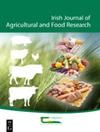对奶牛的生产性能和营养利用进行了研究,青贮饲料由连续三次收获的红三叶草-多年生黑麦草或多年生黑麦草制成
IF 1.4
4区 农林科学
Q3 AGRICULTURE, MULTIDISCIPLINARY
引用次数: 3
摘要
英国和爱尔兰需要减少对进口蛋白质饲料的依赖,这刺激了人们对当地种植的饲料豆科作物的兴趣,包括红三叶草(Trifolium pratense L.)。这项为期13周的研究检测了28头奶牛的生产性能,这些奶牛的青贮饲料分别来自每年315公斤氮/公顷的纯草草(GS)和每年22公斤氮/公顷的红三叶草-多年生黑麦草(RCGS)的连续三次收获。H1、H2和H3的植株枯萎时间分别为48、72和72 h。H1、H2和H3青贮分别饲喂5、5和3周,试验期间奶牛添加8.0 kg精料/d。DM消化率和有效降解蛋白含量,RCGS均低于GS,而蛋白质降解率高于GS。在H1和H2阶段,RCGS的青贮DM采食量高于GS,但在H3阶段差异不显著。在H3时,RCGS的产奶量高于GS,在H1和H2时差异不显著。在H3时,RCGS的乳脂和乳蛋白含量低于GS,但在H1和H2时差异不显著。在H1时,RCGS组的粪便N/N摄取量高于GS组,在H2和H3时差异无统计学意义。在H2条件下,RCGS的总能消化率低于GS。尽管RCGS处理的奶牛生产性能更高,但不同收获期的响应是不同的,这在很大程度上反映了随着季节的进展,RC在草地中所占比例的变化。本文章由计算机程序翻译,如有差异,请以英文原文为准。
Performance and nutrient utilisation of dairy cows offered silages produced from three successive harvests of either a red clover–perennial ryegrass sward or a perennial ryegrass sward
The need to reduce reliance on imported protein feeds within the UK and Ireland has stimulated interest in locally grown forage legume crops, including red clover ( Trifolium pratense L.). This 13-wk study examined the performance of 28 dairy cows offered silages produced from three successive harvests (H) of either a pure grass sward (GS) receiving 315 kg N/ha per annum or a red clover–perennial ryegrass sward (RCGS) receiving 22 kg N/ha per annum. The crops of H1, H2 and H3 were wilted for 48, 72 and 72 h, respectively. Silages from H1, H2 and H3 were offered for 5, 5 and 3 wk, respectively, with cows supplemented with 8.0 kg concentrate/d throughout the experiment. Digestibility of DM and the effectively degradable protein content were lower, while protein degradability was higher, for RCGS than for GS. Silage DM intakes (DMIs) were higher for RCGS than for GS at H1 and H2, with no differences at H3. Milk yield was higher with RCGS than with GS at H3, with no differences at H1 and H2. Milk fat and milk protein contents were lower with RCGS than with GS at H3 but did not differ at H1 and H2. Faecal N/N intake was higher in the RCGS group than in the GS group at H1, with no differences at H2 and H3. Gross energy digestibility was lower for RCGS than for GS at H2. Although cow performance was higher with RCGS treatment, the responses were variable between harvests, largely reflecting the changing proportion of RC in the swards as the season progressed.
求助全文
通过发布文献求助,成功后即可免费获取论文全文。
去求助
来源期刊
CiteScore
2.50
自引率
20.00%
发文量
23
审稿时长
>36 weeks
期刊介绍:
The Irish Journal of Agricultural and Food Research is a peer reviewed open access scientific journal published by Teagasc (Agriculture and Food Development Authority, Ireland). Manuscripts on any aspect of research of direct relevance to Irish agriculture and food production, including plant and animal sciences, food science, agri environmental science, soils, engineering, buildings, economics and sociology, will be considered for publication. The work must demonstrate novelty and relevance to the field of research. Papers published or offered for publication elsewhere will not be considered, but the publication of an abstract does not preclude the publication of the full paper in this journal.

 求助内容:
求助内容: 应助结果提醒方式:
应助结果提醒方式:


